Spin crossover
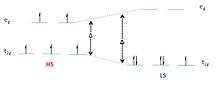
Spin Crossover (SCO), sometimes referred to as spin transition or spin equilibrium behavior, is a phenomenon that occurs in some metal complexes wherein the spin state of the complex changes due to external stimuli such as a variation of temperature, pressure,[1][2] light irradiation or an influence of a magnetic field.[3]
With regard to a ligand field and ligand field theory, the change in spin state is a transition from a low spin (LS) ground state electron configuration to a high spin (HS) ground state electron configuration of the metal’s d atomic orbitals (AOs), or vice versa. The magnitude of the ligand field splitting along with the pairing energy of the complex determines whether it will have a LS or HS electron configuration. A LS state occurs because the ligand field splitting (Δ) is greater than the pairing energy of the complex (which is an unfavorable process).[4]
Figure 1 is a simplified illustration of the metal’s d orbital splitting in the presence of an octahedral ligand field. A large splitting between the t2g and eg AOs requires a substantial amount of energy for the electrons to overcome the energy gap (Δ) to comply with Hund’s Rule. Therefore, electrons will fill the lower energy t2g orbitals completely before populating the higher energy eg orbitals. Conversely, a HS state occurs with weaker ligand fields and smaller orbital splitting. In this case the energy required to populate the higher levels is substantially less than the pairing energy and the electrons fill the orbitals according to Hund’s Rule by populating the higher energy orbitals before pairing with electrons in the lower lying orbitals. An example of a metal ion that can exist in either a LS or HS state is Fe3+ in an octahedral ligand field. Depending on the ligands that are coordinated to this complex the Fe3+ can attain a LS or a HS state, as in Figure 1.
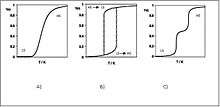
Spin crossover refers to the transitions between high to low, or low to high, spin states. This phenomenon is commonly observed with some first row transition metal complexes with a d4 through d7 electron configuration in an octahedral ligand geometry.[4] Spin transition curves are a common representation of SCO phenomenon with the most commonly observed types depicted in Figure 2 in which γHS (the high-spin molar fraction) is plotted vs. T.[5] The figure shows a gradual spin transition (left), an abrupt transition with hysteresis (middle) and a two-step transition (right). For a transition to be considered gradual, it typically takes place over a large temperature range, even up to several hundred K, whereas for a transition to be considered abrupt, it should take place within 10 K or less.[3]
These curves indicate that a spin transition has occurred in a metal complex as temperature changed. The gradual transition curve is an indication that not all metal centers within the complex are undergoing the transition at the same temperature. The abrupt spin change with hysteresis indicates a strong cooperativity, or “communication”, between neighboring metal complexes. In the latter case, the material is bistable and can exist in the two different spin states with a different range of external stimuli (temperature in this case) for the two phenomena, namely LS → HS and HS → LS. The two-step transition is relatively rare but is observed, for example, with dinuclear SCO complexes for which the spin transition in one metal center renders the transition in the second metal center less favorable.
There are several types of spin crossover that can occur in a complex; some of them are light induced excited state spin trapping (LIESST), ligand-driven light induced spin change (LD-LISC), and charge transfer induced spin transition (CTIST).
History
SCO was first observed in 1931 by Cambi et al. who discovered anomalous magnetic behavior for the tris(N,N-dialkyldithiocarbamatoiron(III) complexes.[6] The spin states of these complexes were sensitive to the nature of their axial ligands. Upon the development of Ligand Field Theory, it became evident that equilibrium could exist between spin states.[7] In the 1960s, the first CoII SCO complex was reported.[8] Magnetic measurements and Mössbauer spectroscopic studies established the nature of the spin transition in iron(II) SCO complexes.[9] Building on those early studies, there is now interest in applications of SCO in electronic and optical displays.[10]
Methods of study
Main methods: X-ray crystallography, Mössbauer spectroscopy, and magnetism
Several techniques that can be used to detect the SCO phenomena in metal complexes. Due to the changes in magnetic properties that occur from a spin transition - the complex being less magnetic in a LS state and more magnetic in a HS state - magnetic susceptibility measurements as a function of temperature are most commonly used in addition to optical spectroscopy and X-ray crystallography. 57Fe Mössbauer Spectroscopy is also another technique employed to detect SCO in iron complexes.
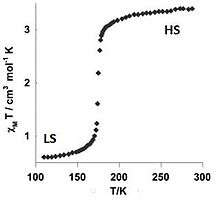
SCO induces changes in metal-to-ligand bond distances due to the population or depopulation of the eg orbitals that have a slight antibonding character. Similarly SCO affects the magnetic properties of the complex. X-ray crystallography, which measure bond distances, thus can provide insight into the spin state of the complex.
The magnetic susceptibility as a function of temperature, (χT) is the principal technique used to characterize SCO complexes. Figure 3 shows an example of a magnetic susceptibility plot. In a HS state have more unpaired electrons than do LS states. The magnetic susceptibility is generally measured from room temperature to liquid helium temperatures with the use of a SQUID instrument which is highly sensitive.[3]
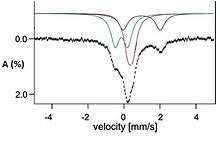
Another very useful technique for characterizing SCO complexes is 57Fe Mössbauer Spectroscopy. This technique can differentiate LS vs HS states, which typically have differing isomer shifts and quadrupole splittings.[3] An example of a Mössbauer spectrum is depicted in Figure 4. The red, blue and green lines are simulations of contributions of LS FeII, HS FeII and LS FeIII respectively to the experimental data for an iron complex at 300 K (black line).
Vibrational spectroscopy
Raman Spectroscopy
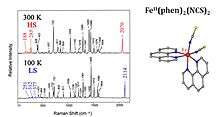
Due to the change in the metal-to-ligand bond distance (M-L) between the HS and LS state, the vibrational modes of the M-L are going to be affected. Vibrational spectroscopy techniques, such as Raman spectroscopy, are going to be sensitive to these M-L vibrational modes. Therefore, Raman spectroscopy can be used to identify which spin state is predominant in a SCO complex. The spin crossover phenomenon is very sensitive to grinding, milling and pressure but Raman spectroscopy has the advantage that the sample does not require further preparation, which is in contrast to Fourier Transform Infrared spectroscopy, FT-IR, techniques; highly colored samples may affect the measurements however.[13] Raman spectroscopy is also advantageous because it allows perturbation of the sample with external stimuli in many ways in order to induce SCO. Thermally induced spin crossover is due to the higher electronic degeneracies of the LS form and lower vibrational frequencies of the HS form, thus increasing the entropy. Figure 5 shows the Raman spectrum of an iron(II) complex in the HS and LS state, emphasizing the changes in the M-L vibrational modes, where a shift from 2114 cm−1 to 2070 cm−1 corresponds to changes in the stretching vibrational modes of the thiocyanate ligand from a LS state to a HS state, respectively.
Fourier Transform Infrared Spectroscopy (FT-IR)
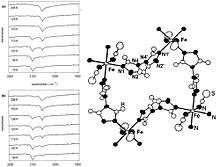

Transitions from a HS to a LS state cause a decrease in the bond distances between the metal center and the ligand. The decrease in the number of antibonding electrons also strengthens the metal-ligand bond in transitions from a HS to LS state. Because the HS and LS states differ with regard to metal-to-ligand bond distances, the harmonic approximation can be assumed. The LS state will have the smaller equilibrium distance - meaning that it has the larger bond force constant, ωLS>ωHS, and the transitions must fall within the thermal energy, kBT .[13] In addition, spin transitions are going to affect the vibrational modes of the ligands. A strong interaction between the metal and the ligand, as is the case of a LS state, is going to cause a shift of the electronic density to the metal causing a weakness of the interligand bonds, and therefore a red shift of their vibrational modes. Figure 6 shows the FT-IR spectrum of an iron(II) cluster at different temperatures. As the temperature decreases, the Fe-N bond distance decreases. Therefore, the CN stretching band shifts to higher frequencies and at higher temperatures, the CN stretching band increases in energy. In this figure, it is shown how the HS state CN stretching band at 2054 cm−1 is predominant at higher temperatures and the LS state CN stretching band at 2099 cm−1 is predominant at lower temperatures, in addition to the different mixed HS and LS state and the fading of this band as the temperatures change. The area under the curves of the absorption peaks for these two states are going to be proportional to the fraction of HS and LS states in the sample. Figure 7 shows a plot of the area under the curves of the absorption peaks as a function of temperature for the same iron cluster (vide supra), showing a large hysteresis loop.
Optical Spectroscopy
UV Spectroscopy
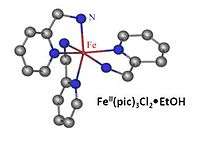

Changes in the (M-L) bond distances are going to affect the symmetry and electronic states of metal complexes. UV-vis spectroscopy is a very useful tool for the determination of the changes of electronic states due to the SCO. For example, the HS and LS states of an FeII compound such as FeII(pic)3Cl2·EtOH, can be followed with UV-vis spectroscopy. The absorption spectra of these FeII molecules at different temperatures clearly show the change in intensities of the spin allowed transitions, due to these symmetric changes. Similarly to FT-IR, the intensities of the absorption bands are proportional to the fraction of metal centers in the corresponding spin state; the more intense the band, the higher the fraction of metal centers in that spin state. In Figure 9, the 5T2→5E absorption band, (left spectrum), corresponds to the HS transition and is centered at 830 nm. The optical density of the HS band is proportional to the γHS, and a γHS vs. temperature can be plotted as in Figure 10. The LS state is seen at a higher energy which is centered at 470 nm (shown on the right in Figure 9).[15] However, the LS state absorption bands are indistinguishable due to the high intensity absorption bands caused by the Metal-to-Ligand Charge Transfer (MLCT) absorption bands.[15]

Perturbation Examples
Thermal Perturbation
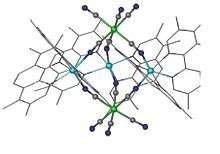

Thermal perturbations are by far the most common type of external stimulus used to induce SCO. There are many examples of complexes that exhibit SCO with the aid of thermal variation. One such example was reported in 2007 by Dunbar et al. in which a pentanuclear cluster exhibits the SCO phenomenon.[11] Figure 11 shows the [FeII(tmphen)2]3[CoIII(CN)6]2 trigonal bipyramid (TBP), with the FeII centers in the equatorial positions and Figure 12 shows a 57Fe Mössbauer spectrum at 300 K for the cluster. Dunbar et al. had found that increasing the temperature causes a major change in the cluster’s electronic structure. The amount of HS FeII present in any sample within the range of 4.2 K to 50 K does not change and remains under 20%, but at room temperature about two-thirds of the FeII ions in the sample of water-containing crystals exhibit a HS state, as shown by the absorption band at 2.1 mm/s, while the other third of the ions remain in the LS state. This shows that either every TBP cluster converts from a [(LS FeII)3CoII2] at 4.2 K to [(LS FeII) (HS FeII)2CoII2] at room temperature or that two-thirds of the clusters change from [(LS FeII)3CoII2] to [(HS FeII)3CoII2] over the same range of temperature. In addition to the crystals containing water, Dunbar et al. studied the effect of interstitial solvent on SCO by studying acetonitrile-containing crystals as well. This study revealed a similar phenomenon but over a lower temperature range, data that support the conclusion that weak effects such as crystal packing environments can affect SCO as well.
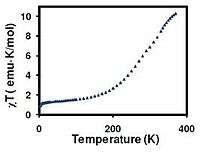
Figure 13 shows the magnetic susceptibility plot of the above TBP which shows a gradual transition from LS (below 100 K) to HS (around 280 K). This gradual transition shows that not all of the FeII centers simultaneously transitioned from the LS state to the HS state as the temperature increases. This confirms the “classical” SCO idea that the Mössbauer measurement had proposed.
Dunbar et al. also obtained X-ray crystallographic data for the TBP crystals at different temperatures. With respect to Figure 11, the equatorial Fe(1) atom is on the left, Fe(2) is in the middle and Fe(3) is on the right. Crystallographic data showed that the average M-L bond lengths for Fe(2) and Fe(3) ions to their respective cyanide ligands at 30 K were 1.94 Å and 1.95 Å and 1.96 Å and 1.96 Å at 110 K, respectively,. This is typical and representative of a LS FeII bond distance. The Fe(1) was significantly higher at 2.11 Å suggesting significant HS FeII character even though typical values reported for HS FeII sites are slightly higher. Typically, bond lengths determined by X-ray crystallography show a small decrease at increasing temperatures due to an increase in the amplitude of atom vibrations, which is the case seen here above 110 K for the average Co-N bond lengths (1.90 Å at 200 K and 1.89 Å at 298 K for the top axial CoIII ion and 1.88 Å at 200 K and 1.84 Å at 298 K for the bottom axial CoIII ion, Figure 11). This however, is not the case for the Fe-N bonds which show a systematic increase. At room temperature, 298 K, the average bond lengths for Fe(1) at 2.17 Å and Fe(3) at 2.15 Å, are typical for HS FeII. The temperature induced change in the cluster geometry indicates a spin transition at these FeII sites. The Fe(2) site does not show a complete spin transition at room temperature however, with an average bond length of only 1.97 Å. Close examination of the crystal structure reveals that Fe(2) is slightly different from the other FeII equatorial sites, in that the 3, 4, 7, 8-tetramethyl-1,10-phenanthroline, (tmphen), ligands on the Fe(1) and Fe(3) centers are engaged in intramolecular p-p interactions with both of the tmphen ligands on the Fe(2) center. With the information provided by these three techniques, it can be concluded that the FeII centers in this pentanuclear complex undergo SCO and that the phenomenon is affected by its coordination and solvent environment.
Pressure Perturbation

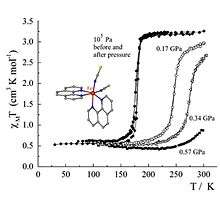
SCO is also influenced by the application of pressure which changes the population of the HS and LS states. Upon application of pressure, a conversion from the HS state to the LS state and a shift from T1/2, (the temperature at which half of the complex is in a LS state), to higher temperatures will occur. This is due to an increase in the zero point energy difference, ΔE°HL, caused by an increase in the relative vertical displacement of the potential wells and a decrease in the activation energy, ΔW°HL, which favors the LS state.[17] Figure 14 shows a schematic of the pressure influence on an FeII-L compound and Figure 15 shows the effect of pressure on the magnetic susceptibility of Fe(phen)2(SCN)2. At high pressures the LS state predominates and the transition temperature increases. At high pressures the compound is almost entirely transformed to the LS state at room temperature. As a result of the application of pressure on the Fe(phen)2(SCN)2 compound, the bond lengths are affected. The difference in M-L bond lengths in both HS and LS states changes the entropy of the system. The change in spin transition temperature, T1/2 and pressure obeys the Clausius-Clapeyron relationship:[17]
The increase in pressure will decrease the volume of the unit cell of the Fe(phen)2(SCN)2 and increase the T1/2 of the system. Figure 16 shows a linear relationship between T1/2 and pressure for the Fe(phen)2(SCN)2, where the slope of the line is .

Light Perturbation
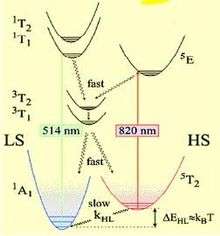
A type of SCO is affected by Light Induced Excited Spin State Trapping (LIESST). In this approach HS and LS states can be triggered by irradiating the sample. At low temperatures it is possible to trap compounds in the HS state - a phenomenon known as the LIESST effect. The compound can be converted back to a LS state by irradiation with a photon of different energy. Irradiation of d-d transitions of the LS metal complex or MLCT absorption bands leads to population of HS states.[18] A good example to illustrate the LIESST effect is the complex [Fe(1-propyltetrazole)6](BF4)2. The sample was irradiated with green light at temperatures below 50 K. By doing this, a spin allowed transition is promoted which is 1A1 → 1T1.[5] However, the 1T1 excited state has a very short lifetime, decreasing the probability for the excited state to relax via a double intersystem crossing to reach the 5T2 HS state .[5] Since the HS state is spin forbidden the lifetime for this state is long, therefore it can be trapped at low temperatures. Figure 17 shows a simplified Jablonski diagram for these transitions. To recover the LS state, irradiation with a lower energy light is done. This promotes a transition from the HS state 5T2 → 5E which allows for relaxation back to the LS state.
Due to the aim to design photoswitchable materials that have higher working temperatures than those reported to date (~80 K), along with long-lifetime photoexcited states, another strategy for SCO called Ligand-Driven Light Induced Spin Change (LD-LISC) has been studied.[19] This method consists of using a ligand that is photosensitive in order to trigger the spin interconversion of the metal ion and exciting this ligand with light. The LD-LISC effect is followed by a structural change of the photoresponsive ligands in contrast to the SCO process where the structures of the ligands are essentially unaffected. The driving force behind the metal ion SCO in this photochemical transformation is cis-trans photoisomerization. The prerequisite for LD-LISC to be observed is that the two complexes formed with the ligand photoisomers, must exhibit different magnetic behaviors as a function of temperature. Upon successive irradiations of the system at two different wavelengths within a temperature range where the metal ion can either be LS or HS, a spin-state interconversion should occur. In order to achieve this, it is convenient to design a metal environment to where at least one of the complexes exhibits a thermally induced SCO. The LD-LISC has been observed in several iron(II) and iron(III) complexes.
Applications

The SCO phenomenon has potential uses as switches, data storage devices and optical displays due to the inherent bistability (HS and LS) which leads to changes in the colour of the material and major magnetic changes.[3] Molecular switches, like electrical switches, require a mechanism that for turning ON and OFF, as is achieved with the abrupt spin transitions with hysteresis. In order for the size of data storage devices to be reduced while the capacity of them increase, smaller units (such as molecules) that exhibit a bistability and thermal hysteresis are required.[3] One research goal is to develop new materials where the SCO response time can be decreased from nanoseconds, as we know it, to femtoseconds. One of the advantages of SCO phenomena is the absence of fatigue, because there is an intraelectronic transition instead of an electron displacement through space. Figure 18 shows a schematic of the two different output signals that can be obtained from an FeII compound upon an external stimuli. Molecules that exhibit SCO could also be used to write an image to a screen when a thermal change induces the SCO.
References
- ↑ Wentzcovitch, R. M.; Justo, J. F.; Wu, Z.; da Silva, C. R. S.; Yuen, D. A.; Kohlstedt, D. (2009). "Anomalous compressibility of ferropericlase throughout the iron spin cross-over". Proc. Natl. Acad. Sci. USA. 106: 8447. arXiv:1307.3270
 . Bibcode:2009PNAS..106.8447W. doi:10.1073/pnas.0812150106.
. Bibcode:2009PNAS..106.8447W. doi:10.1073/pnas.0812150106. - ↑ Wu, Z.; Justo, J. F.; da Silva, C. R. S.; de Gironcoli, S.; Wentzcovitch, R. M. (2009). "Anomalous thermodynamic properties in ferropericlase throughout its spin crossover transition". Phys. Rev. B. 80: 014409. Bibcode:2009PhRvB..80a4409W. doi:10.1103/PhysRevB.80.014409.
- 1 2 3 4 5 6 7 P. Gütlich; H.A. Goodwin (2004). Spin Crossover in Transition Metal Compounds I. Springer Berlin. ISBN 978-3-540-40396-8.
- 1 2 F. Albert Cotton, Geoffrey Wilkinson and Paul L. Gaus (1995). Basic Inorganic Chemistry (3 ed.). Wiley. ISBN 978-0-471-50532-7.
- 1 2 3 4 5 6 José Antonio Real, Ana Belén Gaspar and M. Carmen Muñoz (2005). "Thermal, pressure and light switchable spin-crossover materials". Dalton Trans. (12): 2062–2079. doi:10.1039/B501491C.
- ↑ L. Cambi; L and L. Szego (1931). "Über die magnetische Susceptibilität der komplexen Verbindungen". Chem. Ber. Dtsch. Ges. 64 (10): 2591. doi:10.1002/cber.19310641002.
- ↑ L. Orgel (1956). Tenth Solvay Conference. Brussels.
- ↑ R. Carl Stoufer; Daryle H. Busch; Wayne B. Hadley (1961). "Unusual magnetic properties of some six-coordinate cobalt(II) complexes' electronic isomers". J. Am. Chem. Soc. 83 (17): 3732–3734. doi:10.1021/ja01478a051.
- ↑ Edgar Koenig & K. Madeja (1967). "5T2-1A1 Equilibriums in some iron(II)-bis(1,10-phenanthroline) complexes". Inorg. Chem. 6 (1): 48–55. doi:10.1021/ic50047a011.
- ↑ Michael Shatruk; Carolina Avendano; Kim R. Dunbar (2009). "3. Cyanide-Bridged Complexes of Transition Metals: A Molecular Magnetism Perspective". Prog. Inorg. Chem. Progress in Inorganic Chemistry. 56: 155–334. doi:10.1002/9780470440124.ch3. ISBN 978-0-470-44012-4.
- 1 2 3 4 5 Mikhail Shatruk, Alina Dragulescu-Andrasi, Kristen E. Chambers, Sebastian A. Stoian, Emile L. Bominaar, Catalina Achim and Kim R. Dunbar (2007). "Properties of Prussian Blue Materials Manifested in Molecular Complexes: Observation of Cyanide Linkage Isomerism and Spin-Crossover Behavior in Pentanuclear Cyanide Clusters". J. Am. Chem. Soc. 129 (19): 6104–6116. doi:10.1021/ja066273x.
- ↑ Bousseksou, Azzedine; McGarvey, John J; Varret, Francois; Real, José Antonio; Tuchagues, Jean-Pierre; Dennis, Andrew C; Boillot, Marie Laure (2000). "Raman spectroscopy of the high- and low-spin states of the spin crossover complex Fe(phen)2(NCS)2: an initial approach to estimation of vibrational contributions to the associated entropy change". Chemical Physics Letters. 318 (4-5): 409–416. Bibcode:2000CPL...318..409B. doi:10.1016/S0009-2614(00)00063-4. ISSN 0009-2614.
- 1 2 Jean-Pierre Tuchagues, Azzedine Bousseksou, Gábor Molnár, John J. McGarvey and François Varret (2004). "The Role of Molecular Vibrations in the Spin Crossover Phenomenon". Topics in Current Chemistry. Topics in Current Chemistry. 235: 23–38. doi:10.1007/b95423. ISBN 3-540-40395-7.
- 1 2 Carolien L. Zilverentant; Gerard A. van Albada; Azzedine Bousseksou; Jaap G. Haasnoot; Jan Reedijk (2000). "Infrared detection of the hysteresis in the thermally induced spin-crossover in bis(4,4'-bis-1,2,4-triazole)bis(thiocyanato-N)iron(II) monohydrate". Inorg. Chim. Acta. 303 (2): 287–290. doi:10.1016/S0020-1693(00)00030-X.
- 1 2 3 Andreas Hauser (2004). "Light-Induced Spin Crossover and the High-Spin->Low-Spin Relaxation". Topics in Current Chemistry. 234: 786. doi:10.1007/b95416.
- ↑ Harald Romstedt, Andreas Hauser & Hartmut Spiering (2004). "High-spin --> low-spin relaxation in the two-step spincrossover compound [Fe(pic)3]Cl2EtOH (pic = 2-picolylamine)". J. Phys. Chem. Solids. 59 (2): 265–275. Bibcode:1998JPCS...59..265H. doi:10.1016/S0022-3697(97)00142-X.
- 1 2 3 4 V. Ksenofontov, A. B. Gaspar and P. Gütlich (2004). "Pressure effect studies on spin crossover and valence tautomeric systems". Top. Curr. Chem. Topics in Current Chemistry. 235: 39–66. doi:10.1007/b95421. ISBN 3-540-40395-7.
- ↑ Coen de Graaf & Carmen Sousa (2010). "Study of the Light-Induced Spin Crossover Process of the [FeII(bpy)3]2+ Complex". Chem. Eur. 16 (15): 4550–4556. doi:10.1002/chem.200903423.
- 1 2 Jean-François Létard, Philippe Guionneau & Laurence Goux-Capes (2004). "Towards Spin Crossover Applications". Topics in Current Chemistry. Topics in Current Chemistry. 235: 1–19. doi:10.1007/b95429. ISBN 3-540-40395-7.